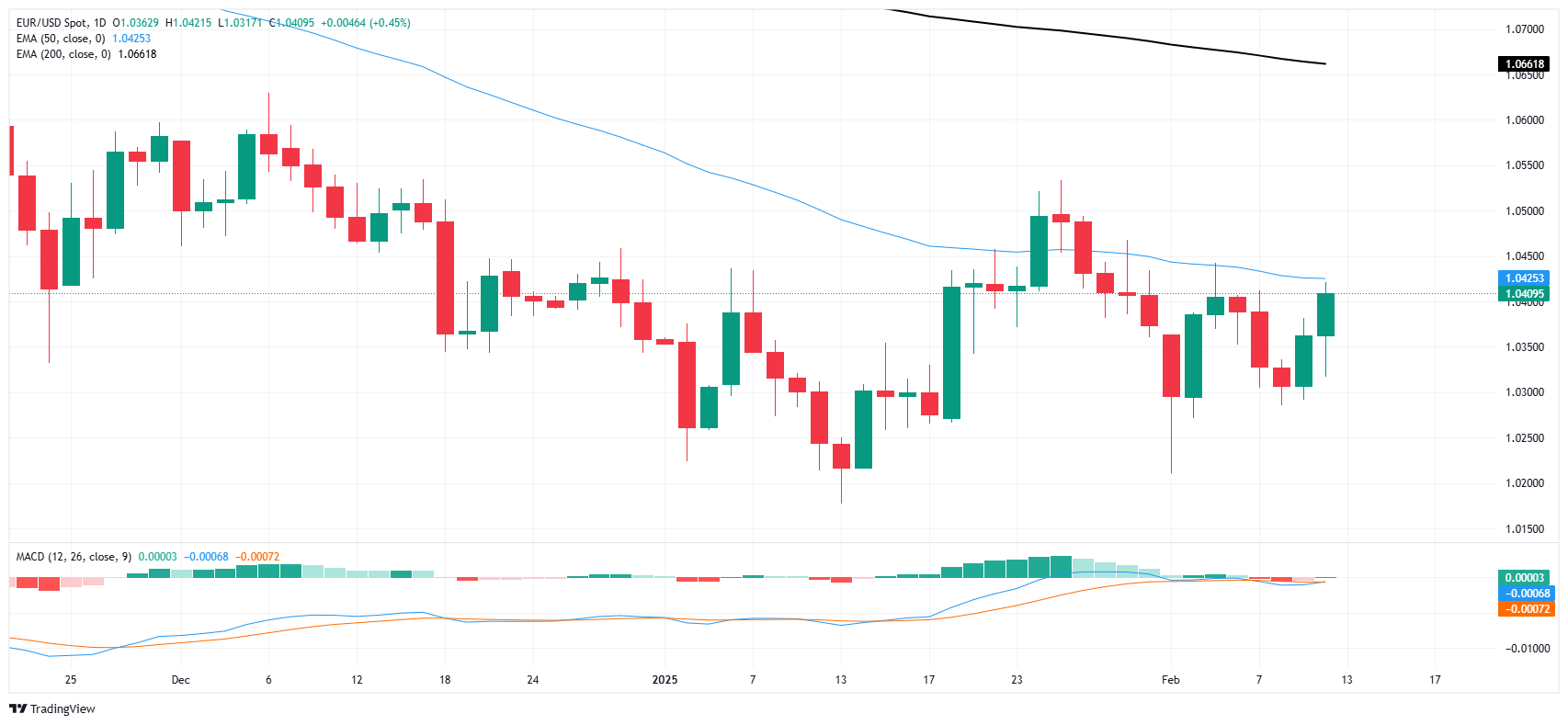EUR/USD reverses early declines, climbs back over 1.04
- EUR/USD gains nearly 50 pips on Wednesday, up around half of a percent.
- Early losses came from a fresh inflation shock after January's US CPI print came in hot.
- Fed Chair Powell's testimony continues in its second day.
EUR/USD clawed back chart paper on Wednesday, rebounding from early losses to reclaim the 1.0400 handle as markets shake off a fresh batch of US inflation figures that broadly accelerated in January. US Consumer Price Index (CPI) numbers came in above forecasts across the board, but markets are absorbing the hit quickly and moving on to fresher headlines.
Read more: Sticky US inflation reinforces the Fed's cautious message
Federal Reserve (Fed) Chair Jerome Powell noted during his second day of testifying before US government bodies. Fed Chair Powell noted that inflation remains a sticky affair, but that the US economy is overall on strong footing. Rate markets have pushed out their bets of another rate cut from the Fed, with rate traders overwhelming expecting the Fed to stand pat until December.
Jerome Powell Testimony Live: We are not there on inflation
EUR/USD price forecast
Never count Euro bulls out of the fight until it's over. EUR/USD clawed back intraday losses and has pushed bids back into the green on Wednesday, sending Fiber back over the 1.0400 handle. EUR/USD remains hampered by the 50-day Exponential Moving Average (EMA) near 1.0430, but a technical floor is priced in near the 1.0300 region.
EUR/USD daily chart
Euro FAQs
The Euro is the currency for the 19 European Union countries that belong to the Eurozone. It is the second most heavily traded currency in the world behind the US Dollar. In 2022, it accounted for 31% of all foreign exchange transactions, with an average daily turnover of over $2.2 trillion a day. EUR/USD is the most heavily traded currency pair in the world, accounting for an estimated 30% off all transactions, followed by EUR/JPY (4%), EUR/GBP (3%) and EUR/AUD (2%).
The European Central Bank (ECB) in Frankfurt, Germany, is the reserve bank for the Eurozone. The ECB sets interest rates and manages monetary policy. The ECB’s primary mandate is to maintain price stability, which means either controlling inflation or stimulating growth. Its primary tool is the raising or lowering of interest rates. Relatively high interest rates – or the expectation of higher rates – will usually benefit the Euro and vice versa. The ECB Governing Council makes monetary policy decisions at meetings held eight times a year. Decisions are made by heads of the Eurozone national banks and six permanent members, including the President of the ECB, Christine Lagarde.
Eurozone inflation data, measured by the Harmonized Index of Consumer Prices (HICP), is an important econometric for the Euro. If inflation rises more than expected, especially if above the ECB’s 2% target, it obliges the ECB to raise interest rates to bring it back under control. Relatively high interest rates compared to its counterparts will usually benefit the Euro, as it makes the region more attractive as a place for global investors to park their money.
Data releases gauge the health of the economy and can impact on the Euro. Indicators such as GDP, Manufacturing and Services PMIs, employment, and consumer sentiment surveys can all influence the direction of the single currency. A strong economy is good for the Euro. Not only does it attract more foreign investment but it may encourage the ECB to put up interest rates, which will directly strengthen the Euro. Otherwise, if economic data is weak, the Euro is likely to fall. Economic data for the four largest economies in the euro area (Germany, France, Italy and Spain) are especially significant, as they account for 75% of the Eurozone’s economy.
Another significant data release for the Euro is the Trade Balance. This indicator measures the difference between what a country earns from its exports and what it spends on imports over a given period. If a country produces highly sought after exports then its currency will gain in value purely from the extra demand created from foreign buyers seeking to purchase these goods. Therefore, a positive net Trade Balance strengthens a currency and vice versa for a negative balance.

